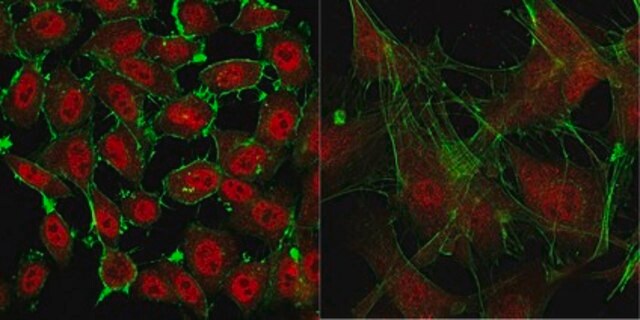A2066
Anti-Actin antibody produced in rabbit

affinity isolated antibody, buffered aqueous solution
Synonym(s):
Rabbit Anti-Actin
About This Item
Recommended Products
biological source
rabbit
Quality Level
conjugate
unconjugated
antibody form
affinity isolated antibody
antibody product type
primary antibodies
clone
polyclonal
form
buffered aqueous solution
mol wt
antigen 42 kDa
species reactivity
wide range, vertebrates, human, slime mold, amoeba, chicken
enhanced validation
independent
Learn more about Antibody Enhanced Validation
technique(s)
immunohistochemistry (formalin-fixed, paraffin-embedded sections): 1:25 using human or animal tissue sections
indirect immunofluorescence: 1:40 using chicken fibroblasts
western blot: 1:100 using chicken gizzard extract
UniProt accession no.
application(s)
research pathology
shipped in
dry ice
storage temp.
−20°C
target post-translational modification
unmodified
Gene Information
human ... ACTA1(58)
mouse ... Acta1(11459)
rat ... Acta1(29437)
Related Categories
General description
The ACTA1 (actin, α 1) gene is mapped to human chromosome 1q42.13. The gene codes for actin 1, a thin filament component of skeletal muscle.
In immunoblotting, the product localizes actin in many species ranging from human skeletal muscle to amoeba. The product recognizes the 42 kDa actin band using immunoblotting techniques in human or animal tissue extracts.
Specificity
Immunogen
Application
Used to study actin structure and function and to probe binding sites of actin-binding proteins. Protein lysates generated from embryonic mouse limb tissue was analyzed by western blot using actin as the loading control. Actin was detected using rabbit anti-actin at 1:8000. Actin detected by a rabbit anti-actin antibody was used as a loading control for MCF7 cell lysates. Actin was detected at 42 kDa.
Biochem/physiol Actions
Mutations in ACTA1 (actin, α 1) is known to cause thin filament myopathy such as nemaline myopathy, congenital myopathy, actin myopathy, intranuclear rod myopathy, cap myopathy and core myopathy. Upregulation of the gene is observed in orthotopic liver transplantation without any earlier evidence of autoimmune liver disease. The encoded protein actin forms a network of filaments and is responsible for the shape of the cell. It provides cellular strength and promotes active movement of the cell.
Physical form
Storage and Stability
For extended storage, the solution may be frozen in working aliquots. Repeated freezing and thawing, or storage in "frost-free" freezers, is not recommended. If slight turbidity occurs upon prolonged storage, clarify the solution by centrifugation before use.
Other Notes
Disclaimer
Not finding the right product?
Try our Product Selector Tool.
recommended
related product
Storage Class Code
12 - Non Combustible Liquids
WGK
WGK 2
Flash Point(F)
Not applicable
Flash Point(C)
Not applicable
Certificates of Analysis (COA)
Search for Certificates of Analysis (COA) by entering the products Lot/Batch Number. Lot and Batch Numbers can be found on a product’s label following the words ‘Lot’ or ‘Batch’.
Already Own This Product?
Find documentation for the products that you have recently purchased in the Document Library.
Customers Also Viewed
Articles
Loading controls in western blotting application.
Our team of scientists has experience in all areas of research including Life Science, Material Science, Chemical Synthesis, Chromatography, Analytical and many others.
Contact Technical Service













